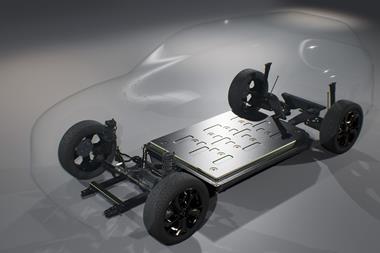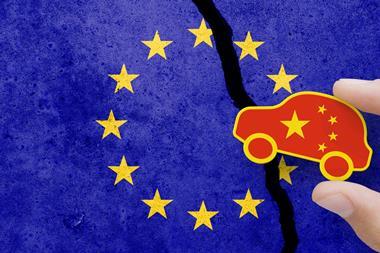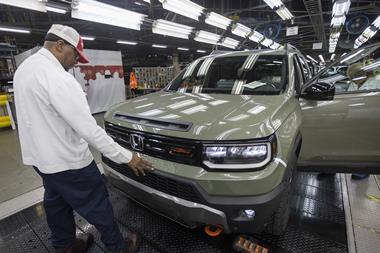
These are hard times for carmakers, no matter where they are located. South Korean producers are facing market downturns, but hope to manufacture their way out of trouble by playing a series of flexible production equipment trump cards.
When it comes to South Korea’s largest carmaker, Hyundai/Kia, nothing is done on a small scale. Since Hyundai’s purchase of the then-floundering Kia in 1998, the two companies have combined to create an automotive juggernaut that commands more than a 50% local market share and exports to 200 nations, selling a total of three million units per year.
The scale continues to impress upon reaching Hyundai/ Kia’s Namyang Research and Development facility. Make no mistake, the place is impressively huge. Yet it has to be, as this is where virtually all the proprietary technology that appears on the Hyundai/Kia production line (and in the finished vehicles) is developed. Generating efficiencies is the name of the game, where smaller rather than larger innovations add up to create considerable cost reductions at the company’s Ulsan, Asan and Jeonju production plants.
Sung-Sup Do is Director of the Manufacturing Engineering Group at the Namyang facility, overseeing projects that will impact every aspect of Hyundai/Kia’s automotive production. In describing the activities taking place at Namyang, it becomes clear that Do believes production line flexibility is of paramount importance in meeting market demands.
“We are developing technology for future manufacturing systems. For example, we are heavily focused on developing flexible manufacturing systems. Market trends and market shares fluctuate, one single event can cause this. The market can be up and down, changing all the time, so we need to manufacture vehicles (to meet these changes).”
Essentially, what Hyundai/Kia is looking to achieve is as flexible a production system as possible, one that is able to switch product mix on any given line. This, to offer an immediate supply of any given vehicle to service the peaks of market demand. What then is the key to creating such a production line?
“To make a flexible manufacturing system, it is better to deploy as many robots as possible. However, a robot is just a manipulator. At the end of the robot is a gripper. If we can develop a gripper that can handle different types of parts for different types of vehicles, then this is good. So we have developed a robot gripper that can handle parts for more than eight different models.”
Do believes that changing the shape of a robot’s gripper is a more elegant solution than having a robot switch interchangeable tools as required.
“Changing the tool every time is a waste of time. The gripper itself cannot be adjusted like this, as well as it saves time in comparison to an auto tool changer. The robot gripper can change itself, according to the operating information in the system. We have already deployed a gripper for the side panel, a front claw handling gripper and also for the front door panel. These functions are combined in the same gripper.”
But how does the gripper adjust itself to accommodate these very different body pieces? “It transforms itself. It can elongate the lengths of the gripping ends. We have developed five different types of schemes to transform the gripper.”
Another technology developed by Do’s team at the Namyang R&D facility was a new plastic laser-welding technique. Where the separate parts of tail lamp lens assemblies had previously been joined using vibration bonding, the laser technique avoided some of the unwanted side effects of this method.
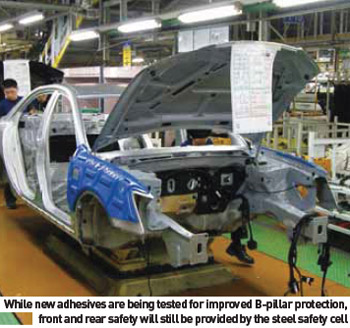 “We deployed a plastic laser welding system for a vendor. Most of the plastic welding for rear combination lamps uses vibration bonding, where the outer lens is welded to the housing. These machines make burrs, due to the vibration and the pressure. To eliminate the burr, we use a diode laser to weld the lens to the housing. On the new Equus, it has a diode laser-welded rear lamp.”
“We deployed a plastic laser welding system for a vendor. Most of the plastic welding for rear combination lamps uses vibration bonding, where the outer lens is welded to the housing. These machines make burrs, due to the vibration and the pressure. To eliminate the burr, we use a diode laser to weld the lens to the housing. On the new Equus, it has a diode laser-welded rear lamp.”
The recently-launched Hyundai Equus luxury saloon is the first model to feature a rear lamp module produced using the plastic laser welding technology. According to Do, new technologies delivered from Namyang are only made available to Hyundai and Kia or their vendor companies.
OEM carmakers will sometimes purchase press dies, for the price and quality of the Hyundai products, but that is where the technology sharing ends.
Further to the joining of rear lamp modules, Do explains how his team has developed a new type of plastic to allow the same laser welding technique to be used for the assembly of headlamp housings.
“Currently we are attempting to make materials here. For example, we have almost finished the development of a new plastic compound to join the headlamp housing. The material of the headlamp (polypropylene) is completely different from the tail lamp (polycarbonate); harder, scratchand heat-resistant.
“The problem was that the plastic used in the headlamp had a different polarity to the housing, so we could not use the laser welding technique. It’s very much like trying to mix oil and water. Recently we have developed a new housing material to match the polarity of the headlamp lens, allowing us to use the same technique.”
Hyundai/Kia is also developing new adhesives, primarily for the purposes of finished vehicle weight reductions, but before being implemented, a suitable product had to be developed.
“We are testing a new adhesive, different from that used on the Genesis saloon and Equus. Adhesive is weak in impact, crash safety. So we are developing adhesives with crashresistant properties that can endure impacts. We are doing this in partnership with Dow Chemical.”
Do explains that Hyundai/Kia has completed development the adhesive, but that it is still undergoing testing. As for where the product would be used, he says that it would be in the area of the B-pillar and bodyside member, as these are the parts designed to independently absorb accident impacts. Elsewhere around the car, the steel chassis is relied on to create the interior safety cell.
Another first for the Equus saloon, much like the rear lamp assembly, is how its bonnet/hood is constructed.
“We use adhesive with the BH, VI and BK models (internal model names, respectively referring to the Genesis, Equus and Genesis Coupe). The hood of a VI is aluminium panel. To join the panels, we used to use self-piercing rivets, because it is very difficult to weld, it melts very quickly and final strength is too low. The current cannot generate enough heat for the weld. We have redeveloped this technology and delivered it to the vendor, they deliver the completed hood. So to make the hood, we use adhesive, together with a new aluminium spot welding technology.”
According to Do, there were two reasons for switching from self-piercing rivets to aluminium spot welding. The first was cost, with each rivet equating to KRW 70 versus KRW 14 for each spot weld; the second being the improved quality and strength offered by spot welding.
The Namyang facility has also been looking into using laser welding as a joining technique. While the company has been using tailor-welded blanks for the past 10 years, supplied by Hysko, laser welding has also been employed on the outer panels of the new Equus.
“The goal of TWBs is to reinforce the panel, to strengthen the panel. In the B-pillar, we reinforce the panel itself. We put different thicknesses together and laser weld these to make TWBs, which are used as inner panels.
“Using laser welding, it was difficult to put (outer) panels together, the appearance would not be of the desired quality. Typically, we would only use this technique as a reinforcement for inner panels. The Equus, though, has a roof panel that is laser-welded to the chassis.”
But was it the design of the roof panel that necessitated using a new bonding technique, or did the availability of the bonding technique allow a different design to be incorporated into the roof?
“Normally we would use spot welding to join these two parts together, but in this case, the spot welding cannot access the area where the join needs to be made. We needed another bonding technology to join the panels and laser welding was the most suitable option. It’s a uni-directional bonding technology that has also increased body strength by about 10%. It’s a stitch weld, not a continuous seam.”

In order to build further flexibility into the body shop, the Manufacturing Engineering Group at the Namyang R&D facility are developing an eight-sided welding buck to replace the current four-sided version. Although this would obviously double the number of individual models that could be welded on a single line, it’s not simply a case of adding four more sets of welding heads.
“We’re currently working with a four-axes main buck, and we’re now working on an eight-model line version,” says Do. “It’s totally different. A new concept.”
The new welding buck is a fully in-house project, with even the welding heads being developed by Hyundai for internal use.
 Do goes onto explain that prototypes for new machinery concepts are developed using virtual modelling, the welding buck still going through this phase. Following this, a trial version of the equipment is built and installed on the fullscale test production line at the Namyang facility before the validated equipment is delivered to the Automation Equipment department, located at Hyundai/Kia’s Ulsan plant, for final build and implementation.
Do goes onto explain that prototypes for new machinery concepts are developed using virtual modelling, the welding buck still going through this phase. Following this, a trial version of the equipment is built and installed on the fullscale test production line at the Namyang facility before the validated equipment is delivered to the Automation Equipment department, located at Hyundai/Kia’s Ulsan plant, for final build and implementation.
The trimshop is another area where new systems are being designed to improve flexible build potential, looking at extending both delivery control and inventory control.
“Because logistics are very important for the trimshop, because all the parts should be assembled in trimshop, we are considering more efficient logistics, otherwise we cannot produce many different model types. Our target is to develop a logistic control system which can produce up to eight different models in one trimshop.”
Do says that the idea is still under development, but continues by saying that a low-cost AGV is already planned to move materials from the shipping dock to lineside.
Once again, the AGVs will be developed in-house by Hyundai’s own team. But as Do comments, AGV technology is relatively static: “AGV is not a new technology.
However, we wanted to reduce the cost of the technology, make it as low as possible. That is the most difficult target.”
Sung-Sup Do was involved with the construction of Hyundai/Kia’s Alabama plant for over four years. He points out that rather than build plants to a fixed layout or plan, Hyundai prefers to incorporate new ideas as they become available.
“I participated in constructing Asan and Alabama, I joined the construction team. It (the Alabama plant) looks quite different. Construction there is different, but the common theme in Hyundai is to build the most efficient factory at that moment. We put all our energy into that.”
 Are there any key differences in the tooling and layout between plants? Upon visiting Alabama, would it look like a Korean plant?
Are there any key differences in the tooling and layout between plants? Upon visiting Alabama, would it look like a Korean plant?
“No, ours (in Korea) are quite different in terms of layout. The trimshop at the Asan plant is constructed in a rectangular shape, where Alabama has an F-shaped configuration. The reason for this unique layout is to improve logistics, lineside delivery, so the container can better access point of use.
“Since then, we’ve gone on to build plants in the Czech Republic, China and India, which are newer and more efficient. So with each successive plant, we take more steps to improve efficiencies.”
In spite of the more favourable layouts, Do says that Hyundai will not be revisiting any current plant to incorporate what they have learned. “It’s almost not worth it. It’s not economically viable.”
That said, Hyundai/Kia’s director of manufacturing engineering still has a few more tricks up his sleeve. “Right now, I have 165 ongoing projects to improve the manufacturing process – and those are just the ones that have been approved!”
Flexibility is paramount at GM Daewoo
GM Daewoo has four manufacturing facilities in Korea, with two plants in the Bupyeong site, another in Gunsan, 250km south-west of Seoul and another in Changwon, about 400km south-east of Seoul. In a meeting which had each of the manufacturing directors of the Bupyeong facility in attendence, the discussion focused on the same two topics: cost savings and manufacturing flexibility.
One recent example of built-in line flexibility is a new machine that, in conjunction with a lifter, moves completed car bodies from the weldshop through to paint.
“The equipment is called a server flexible hanger,” says Jin- Soo Park, Managing Director of Manufacturing Engineering.
“There are several different methods of installing and using a flexible hanger. GM Daewoo Tooling Centre and GM Daewoo Mechanical Engineers jointly developed the equipment; it is designed and installed to accommodate nine different model types.”
How does the machine accommodate nine separate models?
“We call it servomotor-driven positioning; we can control the location and positioning (of the hanger) regardless of bodystyle. It’s a commonized locating system that is styledriven.”
A variety of systems, including the ME design, allow for different types of panels to be handled. According to Park, when a vehicle is being designed, a common location needs to be incorporated in the panel design to allow the system to accommodate different panels. From the very early stages of vehicle design, this has to be reflected in the vehicle architecture. That said, it is a full complement of information that allows the system to accurately determine the correct point at which to pick up a panel.
“There are three things (that set up the hanger correctly).
The production ordering system is linked with the control system so the servomotor moves the tool to the appropriate position for that size of vehicle. When the vehicle approaches, the equipment checks for a robust marriage between the lifter and the panel of the vehicle. The proximity sensor then checks that the panel and lifter are married in the correct location.”
Much like Hyundai/Kia, GM Daewoo employs tailor-welded blanks in its vehicles. According to Park, the technology was developed in-house before being passed to a supplier for reasons of economy.
“We made the TWB in-house for pilot production, so we have done pilot testing of TWBs in the initial stages of development. In the early stages of Daewoo, we had to prove the quality of the blanks, but it later became a proven technology. POSCO (Pohang Iron and Steel Company) had mass-production capabilities, so we released our requirement for TWBs and they supply these to us.”
Again similar to Hyundai/Kia, the majority of steel used by GM Daewoo is sourced in Korea from POSCO, with the remainder coming through GM’s global supply chain, including such as China and Japan
When it comes to putting the blanks together, what techniques are used, what kind of welding equipment, adhesives and fixings?
“We use laser welding or seam welding for putting blanks together,” says Park. We have many technologies for body welding, but just two or three for blank welding.
“For body welding, we mostly use spot-weld guns. In areas where we cannot use spot welds we use glazing welds.
So separate from this, for individual parts, we use clinch welding. We use laser welding for the roof upper panel, so there are four distinctly different methods. We also use sealers and adhesives in the BIW process, but its welding that returns the required strength and stiffness.
To supply the BIW line, the Bupyeong facility operates nine press lines, the machinery being largely supplied by the Japanese firm Komatsu.
When AMS visited the GM (Vauxhall) plant in November/ December 2008 issue, a point of note was the new global glazing cell that had been recently installed in anticipation of the next-generation Astra. Does GM Daewoo have that same global cell installed at Bupyeong?
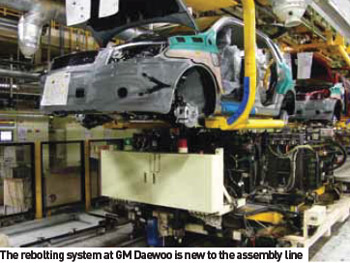 “There are many ways to install glass, but basically, a robot cell is selected based on the car body shape,” explains Park.
“There are many ways to install glass, but basically, a robot cell is selected based on the car body shape,” explains Park.
“We try to maximize the commonality of the equipment, we commonize most of the systems. We specially design equipment if there are peculiarities for a given product.
That is why we call it a global glass cell, because we try to cover most of the products in a global unit. We were able to save a significant amount of facilities-related cost through commonization. We also have a favourable maintenance arrangement of this type of equipment, globally.
“The term global cell can be misleading, in that one equipment does all operations. So we need to be careful of using that term. We track and control our design reuse rate globally, by press, body, paint and GA, so there is a design developed by a leading vehicle, the first vehicle produced off a given architecture. The first lead programme organization is called ‘homeroom’. The design that the homeroom develops is used by following programmes. We have GM Global Councils that set up (machine) reuse targets; for example, 70% should be reused, and we try and achieve those targets in the later vehicle programmes.
Following on from the example, there’s a 70% use of globally-standardized equipment and another 30% that can be customized to help meet your model mix needs?
“That’s correct. So there is a GM Global entity and we are a region within that. When we want to deviate from a global strategy, each region must request deviation approval, to use a different, not-globally common equipment. When that is approved, we would choose a not globally-common equipment which would go into that 30%.”
A further example of this is in the paint shop, which featuring main booth facilities supplied by Durr and Taikisha and robotics from Yaskawa (Motoman), Durr and Fanuc. According to the explained principle, and with its long-standing partnership, are Fanuc machines in the majority?
“We have common standards with other global GM plants.
We have a global GM supply chain and purchasing policy. We enter into contracts on an annual basis, we look for bids worldwide and the lowest bidder wins the contract. We utilize those vendors on a turnkey basis. Using GM’s global buying power, we can source required equipment at a very competitive price.”
Like many carmakers, GM Daewoo has its own on-going programme of production line machine development. One such innovation are so-called ‘high-density robots’, where through the intrinsic design, the robotics will be able to dramatically improve production timeframes.
“A lot of our work in this area is highly confidential.
There are new technology projects, but it is difficult for me to disclose that information at this point. It is very confidential even within the GM organization. One project I can mention, that will potentially be used to manufacture a future model is the high-density robot, meaning that it can be installed in a very restricted area. It can weld multiple points in a short period of time and the space can be immediately cleared.
“On a conventional station you can fit maybe six robots.
With this system, we can install many times more highdensity robots in the same space. In one operation, we can raise a significant number more welding points than with conventional robots. We might expect this technology to be on the line within 18 – 24 months.”
Clearly, time is money and improving efficiencies in production will save time. New production technologies will dramatically improve assembly times at both Hyundai/ Kia and GM Daewoo, while still helping to increase model mix flexibility. The importance of delivering more finished vehicles of the type customers want to buy cannot be understated and in Korea, through the use of improved manufacturing technologies, carmakers are determined to load the deck in their favour by making this happen.































